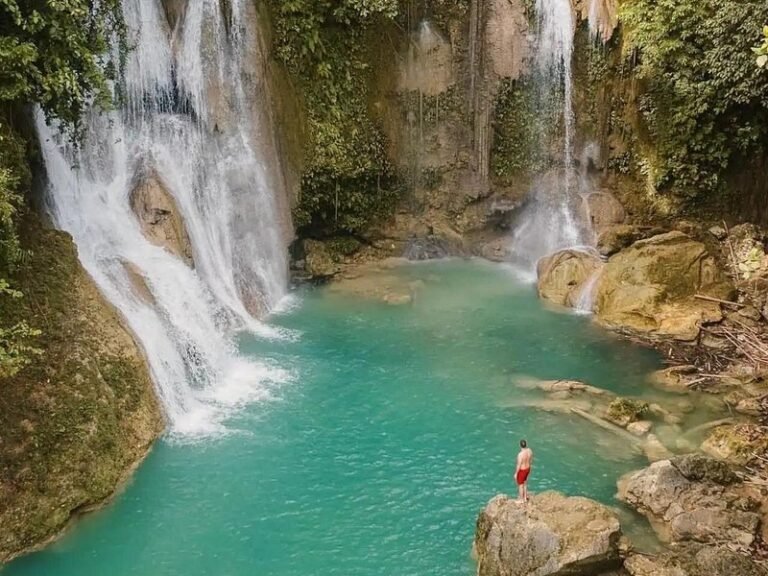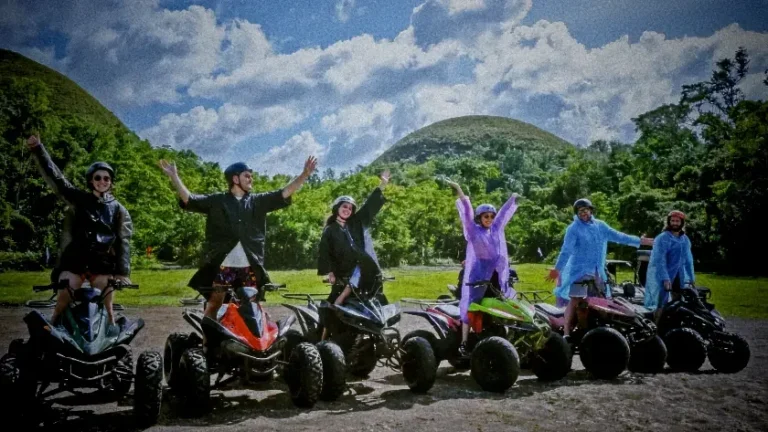Things to Do in Cebu in July 2025: Peak Wet Season & Typhoon Adventures
July in Cebu represents the heart of the Southwest Monsoon season, bringing the most intense tropical weather patterns of the year. This is when nature displays its full power through torrential rains, spectacular lightning shows, and occasional typhoon activity. For the adventurous traveler, July offers the ultimate tropical storm experience, rock-bottom prices, and the chance to witness Cebu’s dramatic weather at its most magnificent and humbling.
Why July is Cebu’s Most Dramatic Month
All Bohol and Cebu Tours & Excursions in 2025
- 👉 Secure your Bohol adventure before spots sell out” — trusted by 50K+ travelers with instant confirmation
- 👉 Swim with whale sharks tomorrow”” — last-minute Cebu packages with guaranteed availability
- 👉 Why choose when you can have both?” — Bohol + Cebu packages from ₱5,999
- “Book now, decide later with free cancellation”
Peak Monsoon Intensity July delivers the most powerful weather systems of the year, with typhoons possible and daily thunderstorms reaching their most spectacular intensity.
Ultimate Budget Travel Tourist numbers hit their absolute lowest, creating unprecedented bargains and authentic local experiences without any international crowds.
Maximum Natural Drama Experience tropical weather at its most powerful – from gentle morning mists to afternoon deluges to evening lightning displays that illuminate entire horizons.
Typhoon Season Awareness While typhoons are possible, most pass north of Cebu. When they do approach, they create some of the most awe-inspiring (safely observed) natural phenomena imaginable.
Weather in Cebu in July
- Temperature: 24-29°C (75-84°F) – Coolest due to constant cloud cover
- Rainfall: Very heavy (18-25 rainy days with intense precipitation)
- Humidity: Extreme (90-95%) – Peak tropical saturation
- Sea conditions: Often rough with reduced ferry schedules
- Typhoon potential: 1-3 systems may affect the region
- Rain intensity: Torrential downpours, flash flood potential
- Sunrise: Around 5:50 AM (often obscured)
- Sunset: Around 6:25 PM (frequently dramatic when visible)
What to Pack:
- Professional-grade waterproof gear (rain suits, not just jackets)
- Multiple pairs of waterproof shoes
- Waterproof bags for all belongings
- Emergency supplies (flashlight, portable charger, first aid)
- Antifungal medications and treatments
- Entertainment for extended indoor periods
- Typhoon preparedness kit (if staying long-term)
- Quality dehumidifier sachets for electronics
Top Things to Do in Cebu in July
Typhoon and Storm Watching (From Safety)
1. Hotel Storm Observation Decks Experience the raw power of tropical storms from secure, elevated hotel locations. Many properties offer storm-watching experiences with refreshments and expert commentary.
2. Covered Beachfront Pavilions Watch massive waves and lightning displays from protected oceanfront positions. The contrast between nature’s fury and human shelter creates unforgettable experiences.
3. Weather Radar and Tracking Education Learn to read weather patterns with local meteorologists. Many hotels and tour operators offer educational storm-tracking sessions during typhoon approaches.
4. Traditional Filipino Storm Traditions Experience how locals prepare for and weather typhoons. Participate in community preparation activities and learn traditional storm survival wisdom.
Maximum Indoor Cultural Immersion
5. Extended Filipino Family Experiences Connect with local families who welcome visitors during long indoor periods. Experience authentic Filipino hospitality during extended weather delays.
6. Traditional Craft Mastery Dedicate weeks to learning guitar making, wood carving, or weaving. July’s extended indoor periods allow for deep skill development impossible during tourist season.
7. Language Immersion Programs Intensive Cebuano or Tagalog learning during indoor periods. Native speakers have time and patience for extended language exchange during storm season.
8. Filipino Literature and Storytelling Discover rich Filipino literary traditions through extended reading sessions and storytelling circles common during monsoon season.
Peak Flow Water Experiences
9. Kawasan Falls at Maximum Power Witness waterfalls at their most spectacular with massive volume from continuous rains. Swimming becomes impossible, but the visual and auditory experience reaches peak intensity.
10. Mountain Stream Adventures Explore mountain areas where streams become raging torrents. Guided tours show the dramatic transformation of normally gentle waterways.
11. Hot Springs in Cool Weather Mountain hot springs become incredibly therapeutic when outside temperatures drop during constant rain and cloud cover.
12. Covered Thermal Pools Indoor and covered hot spring facilities provide perfect relief from cool, humid outdoor conditions while maintaining connection to natural water.
Storm Photography and Documentation
13. Lightning Photography Workshops Learn safe techniques for capturing dramatic electrical displays. Local photographers offer specialized monsoon photography classes.
14. Flood Documentation Projects Responsibly document how communities adapt to seasonal flooding. Important cultural and environmental photography opportunities.
15. Atmospheric Landscape Capture Photograph Cebu’s most dramatic landscapes with mist-covered mountains, swollen rivers, and otherworldly cloud formations.
16. Traditional Architecture in Storms Document how Filipino architecture adapts to extreme weather. Traditional buildings reveal their storm-resistant design principles.
Community Integration Activities
17. Volunteer Storm Relief Preparation Assist local communities with typhoon preparation activities. Meaningful cultural exchange while contributing to community resilience.
18. School and Community Center Programs Join indoor activities at schools and community centers. Educational and cultural exchange opportunities increase during indoor periods.
19. Religious and Spiritual Experiences Participate in prayer services and spiritual gatherings common during intense weather periods. Deep cultural and spiritual experiences.
All Bohol and Cebu Tours & Excursions in 2025
- 👉 Secure your Bohol adventure before spots sell out” — trusted by 50K+ travelers with instant confirmation
- 👉 Swim with whale sharks tomorrow”” — last-minute Cebu packages with guaranteed availability
- 👉 Why choose when you can have both?” — Bohol + Cebu packages from ₱5,999
- “Book now, decide later with free cancellation”
Typhoon Preparedness and Safety
Understanding Typhoon Categories
- Tropical Depression: 61 km/h winds or less
- Tropical Storm: 62-88 km/h winds
- Typhoon: 89+ km/h winds with multiple categories of intensity
Safety Protocols
Before Typhoon Approach:
- Monitor official weather services (PAGASA)
- Secure accommodation with generator backup
- Stock emergency supplies (water, food, medications)
- Charge all electronic devices
- Understand evacuation routes and procedures
During Typhoon Passage:
- Stay indoors in reinforced buildings
- Avoid windows and glass surfaces
- Never venture outside during eye passage (calm period)
- Monitor official communications for updates
- Document experience from safety
After Typhoon Passage:
- Wait for official all-clear before venturing outside
- Watch for flooding, downed power lines, and debris
- Assist community cleanup efforts if safe
- Report damage to proper authorities
July Accommodation Strategy
Storm-Resistant Properties: Choose modern buildings with generator backup, reinforced construction, and experienced storm management protocols.
Community-Focused Locations: Properties that function as community gathering places during storms provide better cultural experiences and safety networks.
Backup Systems Priority: Reliable power, water, and communication systems become essential rather than luxury amenities.
Best Storm-Season Accommodations:
Typhoon-Proof Luxury:
- Shangri-La Mactan: Superior storm protocols and backup systems
- Marco Polo Plaza: Reinforced construction with excellent emergency procedures
- Crimson Resort: Modern engineering with community shelter areas
Storm-Smart Mid-Range:
- Quest Hotel: Central location with reliable infrastructure
- Waterfront Hotel: Experienced storm management with community facilities
- Sugbutel Family Hotel: Local expertise in typhoon preparation
Budget Storm Shelters:
- Z Hostel: Modern construction with backup systems
- Mad Monkey Hostel: Community atmosphere perfect for storm periods
Monsoon and Typhoon Cuisine
Storm Preparation Foods:
- Canned goods: Essential typhoon supplies that locals share
- Dried fish: Traditional preservation methods for extended indoor periods
- Rice stocks: Staple food that stores well during weather events
- Root vegetables: Hardy foods that survive storm disruptions
Community Storm Cooking:
- Shared meals: Community cooking during power outages
- Simple preparations: Foods that can be prepared with minimal resources
- Comfort foods: Traditional dishes that provide emotional comfort
- Storm snacks: Easy-to-prepare foods during weather events
Post-Storm Celebrations:
- Fresh ingredients: Incredible flavor of fresh foods after storm clearing
- Community feasts: Celebration meals when weather improves
- Seafood abundance: Often excellent fishing after storms pass
- Tropical fruits: Peak flavor from rain-washed fruits
Health Considerations During Peak Wet Season
Extreme Humidity Management:
- Spend maximum time in air-conditioned environments
- Use dehumidifiers in sleeping areas
- Change clothes multiple times daily
- Monitor for heat rash and fungal infections
Mental Health During Storms:
- Accept slower pace and indoor confinement
- Connect with others during extended indoor periods
- Find beauty in dramatic weather rather than frustration
- Maintain routines despite weather disruptions
Physical Safety:
- Never attempt outdoor activities during severe weather
- Understand flash flood risks and evacuation procedures
- Maintain emergency supplies and communication devices
- Follow all local authority guidance during weather events
Why July is Cebu’s Most Intense Experience
July in Cebu strips away all pretense and reveals nature’s overwhelming power. This is when you truly understand what “tropical” means – not just warm beaches and palm trees, but the full spectrum of weather that shapes cultures, architectures, and ways of life.
The month demands respect for natural forces while providing some of the most awe-inspiring experiences possible. Watching a typhoon approach from safety, hearing torrential rain drum on roofs for hours, and witnessing the incredible freshness that follows each storm creates profound appreciation for both nature’s power and human resilience.
July offers the deepest possible cultural immersion because you experience exactly what locals experience. When you’re sharing storm stories in a local café while rain pounds outside, learning traditional crafts during extended indoor periods, or helping communities prepare for typhoons, you’re participating in authentic Filipino life rather than observing it.
The month teaches patience, humility, and the art of finding profound beauty in nature’s most dramatic displays. You’ll discover that some of travel’s most memorable moments come not from perfect weather, but from experiencing and respecting the full power of tropical climate systems.
July in Cebu isn’t for everyone – but for those who embrace it, the experience provides insights into tropical life, community resilience, and natural beauty that no amount of sunny beach days can match.
Come experience Cebu when nature reminds humans of their place in the greater scheme of things – powerful, humbling, and absolutely unforgettable!
All Bohol and Cebu Tours & Excursions in 2025
- 👉 Secure your Bohol adventure before spots sell out” — trusted by 50K+ travelers with instant confirmation
- 👉 Swim with whale sharks tomorrow”” — last-minute Cebu packages with guaranteed availability
- 👉 Why choose when you can have both?” — Bohol + Cebu packages from ₱5,999
- “Book now, decide later with free cancellation”
Island Adventures Await: Cebu’s 2025 Calendar
What’s On in Bohol & Cebu: Your Complete Events Calendar
Every month brings magic to Bohol and Cebu, from world-famous street dancing festivals to intimate community celebrations that showcase authentic Filipino culture. With over 2 million visitors annually drawn to these islands’ rich calendar of events, timing your visit right can mean the difference between experiencing a once-in-a-lifetime cultural immersion or fighting crowds for a glimpse of the action.
Things to Do in Cebu in October 2025: Pleasant Weather Returns & Tourism Revival
October in Cebu marks the triumphant return of paradise conditions as the monsoon finally retreats and the beloved dry season begins. This month delivers the perfect balance: reliably pleasant weather with occasional refreshing rain showers, awakening…
Things to Do in Cebu in August 2025: Hot Monsoon Breaks & Late Wet Season
August in Cebu delivers a unique tropical experience: scorching hot and humid conditions punctuated by intense monsoon downpours. This month combines the worst of both seasons – blistering heat when it’s not raining and torrential storms…
Things to Do in Cebu in January 2026: Sinulog Festival & Perfect Weather
January in Cebu is absolutely electrifying. The month kicks off with the world-famous Sinulog Festival, transforming the entire province into a massive celebration of culture, faith, and Filipino heritage. Combined with the continuation of the dry…
Things to Do in Cebu in June 2025: Monsoon Season & Rainy Day Adventures
June in Cebu marks the full arrival of the Southwest Monsoon (Habagat), transforming the Queen City into a lush, green paradise punctuated by dramatic daily downpours. While many travelers avoid the wet season, savvy visitors discover…
Things to Do in Cebu in February 2025: Romance, Diving & Peak Dry Season
February in Cebu is pure paradise. As the post-Sinulog crowds disperse and Valentine’s Day approaches, the Queen City transforms into a romantic tropical haven with the year’s most perfect weather conditions. Crystal-clear seas reach peak visibility…
Things to Do in Cebu in April 2025: Peak Summer Heat & Water Paradise
April in Cebu is summer at its most intense and magnificent. With temperatures soaring to their annual peak and sunshine blazing from cloudless skies, this month transforms the Queen City into the ultimate water paradise. Easter…
Things to Do in Cebu in May 2025: Wet Season Transition & Pre-Monsoon Adventures
May in Cebu brings welcome relief from April’s scorching heat as afternoon thunderstorms begin to cool the air and refresh the landscape. This transitional month offers the perfect balance of tropical warmth and cooling rains, creating…
Things to Do in Cebu in November 2025: Peak Pleasant Weather & High Season Begins
November in Cebu represents the pinnacle of tropical perfection – when ideal weather conditions meet full tourism operations to create the quintessential Philippine paradise experience. As the last traces of monsoon disappear and the dry season…
Things to Do in Cebu in September 2025: Monsoon Retreat & Weather Transition
September in Cebu marks the beginning of hope – when the relentless monsoon finally starts its gradual retreat and glimpses of the coming dry season appear. This transitional month offers the best of both worlds: continued…
Things to Do in Cebu in March 2025: Hot Season Adventures & Shoulder Season Perks
March in Cebu marks the exciting transition into the hot season, bringing blazing sunshine, crystal-clear skies, and the year’s most vibrant energy. As temperatures rise and crowds thin out after peak season, savvy travelers discover March’s…
Things to Do in Cebu in December 2025: Your Complete Holiday Guide
December in Cebu is nothing short of magical. As the rest of the world shivers through winter, the Queen City of the South welcomes visitors with warm tropical breezes, vibrant Christmas celebrations, and perfect weather for…
All Bohol and Cebu Tours & Excursions in 2025
- 👉 Secure your Bohol adventure before spots sell out” — trusted by 50K+ travelers with instant confirmation
- 👉 Swim with whale sharks tomorrow”” — last-minute Cebu packages with guaranteed availability
- 👉 Why choose when you can have both?” — Bohol + Cebu packages from ₱5,999
- “Book now, decide later with free cancellation”







